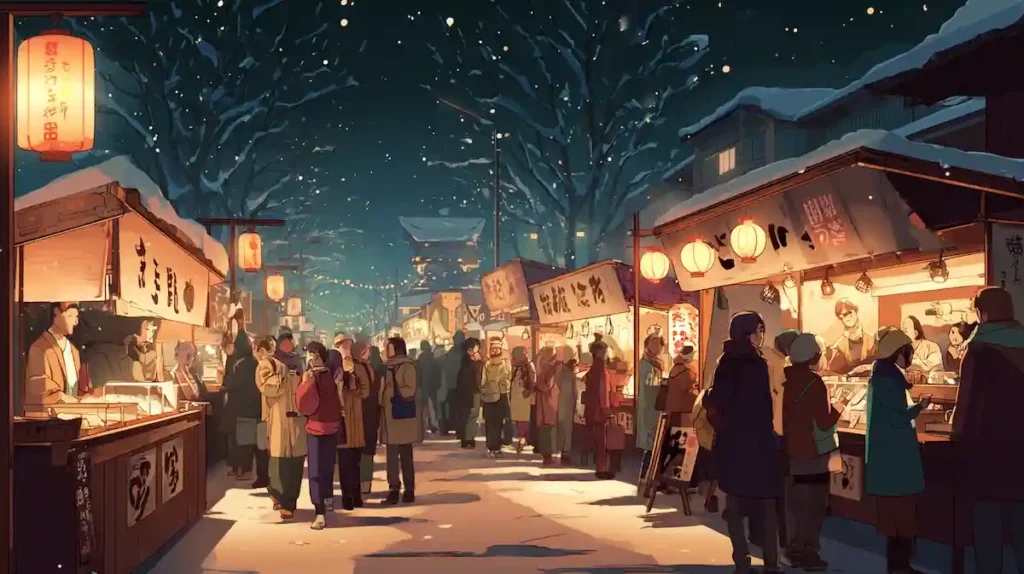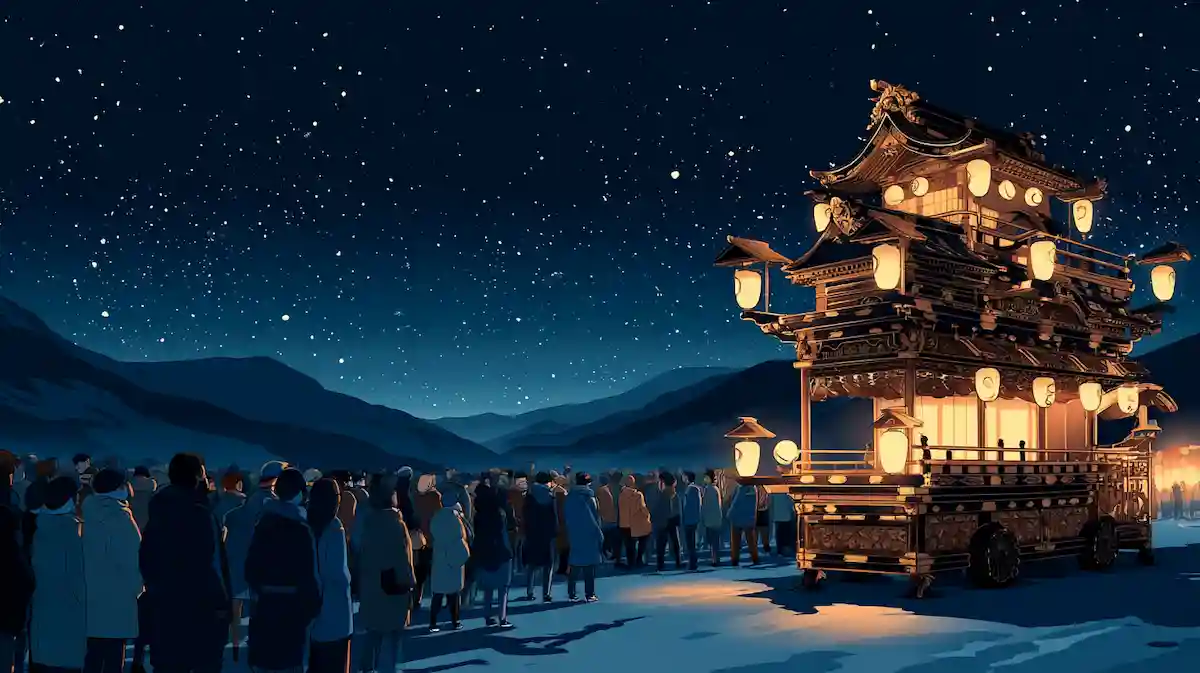秩父夜祭を英語で説明・紹介するための基本情報と、英会話に役立つ表現をシンプルでわかりやすい英語で紹介します。
英会話ダイアローグ・概要・10の質問を通して、秩父夜祭に関する英語表現を学びます。
英語
英会話ダイアローグを読む前に知っておくと良い前提知識と情報です。
- 基本情報
- 埼玉県秩父市・秩父神社周辺で、毎年 12月2日・3日に開催
- 「日本三大曳山祭」の一つで、京都の祇園祭・高山祭と並び称されるほど有名で豪華絢爛な祭り
- 2016年、ユネスコ無形文化遺産に登録
- 主な見どころ
- 豪華な山車
- 高さ約7メートル、重さ最大20トン
- 金箔や彫刻で豪華に装飾され、夜は提灯でライトアップ
- 団子坂の曳き上げ
- 急な坂を、数百人で巨大な山車を一気に引き上げる迫力満点のクライマックス
- 冬の花火
- 12月の澄んだ夜空を彩る大規模な打ち上げ花火
- 山車と花火の共演は幻想的
- 豪華な山車
- アクセスとご当地グルメ
- 東京からは電車で約2時間、西武鉄道「西武秩父駅」または秩父鉄道「秩父駅」から徒歩10分程度
- みそポテト、わらじカツ丼、甘酒など、秩父名物が楽しめる
2人が秩父夜祭について話しています。
豪華な山車や冬の花火、ユネスコ無形文化遺産としての価値、ご当地グルメ、アクセス方法などを話題にしています。
会話 / dialogue

Hey Key, have you ever heard of the Chichibu Night Festival? I saw some photos online, and it looked amazing!

Of course! It’s one of Japan’s most famous winter festivals. It’s held every year on December 2nd and 3rd in Chichibu, Saitama. Are you thinking of going?

Yeah, I’m really curious. What makes it so special compared to other festivals in Japan?

Well, first of all, it’s one of Japan’s Three Great Float Festivals, along with the Gion Festival in Kyoto and the Takayama Festival. The huge floats are the main highlight.

Floats? Like portable shrines?

Not exactly. These are called “Yatai” and “Kasaboko.” They’re massive, beautifully decorated floats, about 7 meters tall and weighing up to 20 tons.

Wow, 20 tons? How do they even move them?

Hundreds of people pull them with thick ropes. The most exciting part is when they drag them up a steep slope called Dango-zaka on the night of December 3rd. The energy is unbelievable!

That sounds intense! Are there any other highlights?

Definitely. The festival is famous for its winter fireworks. It’s rare to see such a big fireworks display in December, and when the floats and fireworks come together, it’s breathtaking.

Fireworks in December? That’s unusual. Does it get really cold?

Yeah, it’s pretty chilly, often below 5°C at night. But the atmosphere and excitement make you forget the cold.

I guess it must be really crowded then, right?

Absolutely. Over 200,000 people visit every year. If you plan to go, it’s better to arrive early or even book a viewing spot in advance.

Good tip. So, is the festival very old?

Yes, it started over 350 years ago during the Edo period. It was originally connected to the silk trade and Chichibu’s local economy.

Oh, I didn’t know that. It’s not just entertainment, then—it has cultural roots.

Exactly! In fact, the festival was registered as a UNESCO Intangible Cultural Heritage in 2016, so it’s recognized worldwide.

Nice! Do they have any traditional performances during the festival?

Yes, there are Kabuki-style plays and traditional dances performed on the floats. The music, drums, and flutes make it feel like you’ve stepped back in time.

That sounds amazing. Are there food stalls too? I want to try something local.

Of course! You can try Chichibu specialties like miso potatoes, waraji katsudon, and hot amazake. Perfect for a cold night!

Yum! Sounds like I should spend the whole day there. How do we get to Chichibu from Tokyo?

The easiest way is to take the Seibu Railway or Chichibu Railway. It takes about two hours from central Tokyo.

Two hours isn’t bad at all. I think I’m going to plan a trip for December. Want to join me?

Absolutely! We can enjoy the floats, fireworks, and food together. Trust me, the Chichibu Night Festival is an experience you’ll never forget!
概要 / Overview
「秩父夜祭」について、理解を深めるための「英語での概要」です。
秩父夜祭

Overview
The Chichibu Night Festival is one of Japan’s most famous winter festivals. It takes place every year on December 2nd and 3rd in Chichibu City, Saitama Prefecture. The festival is the annual celebration of Chichibu Shrine and has a history of more than 350 years. In 2016, it was added to the list of UNESCO Intangible Cultural Heritage, which shows its cultural importance.
Magnificent Floats
The main attraction of the festival is the beautiful floats, called yatai and kasaboko. Some floats are about 7 meters tall and weigh up to 20 tons. They are decorated with gold, carvings, and lanterns. At night, the floats are lit up and create a magical atmosphere. The most exciting moment is when hundreds of people pull the heavy floats up a steep slope called Dango-zaka. The powerful shouts, drums, and flutes make the scene unforgettable.
Winter Fireworks and Performances
Another highlight is the winter fireworks. It is rare to see such a big fireworks display in December. The combination of bright floats and fireworks is breathtaking. The festival also has Kabuki-style plays and traditional dances performed on the floats. Visitors can enjoy local music and experience the lively Edo-period atmosphere.
Access and Popularity
Every year, more than 200,000 people visit the festival. The easiest way to get there is by train, using the Seibu Railway or Chichibu Railway, which takes about two hours from Tokyo. The festival is very crowded, so it is better to arrive early or reserve a viewing spot in advance.
10の質問 / 10 questions
「秩父夜祭」について、理解を深めるための「英語での10の質問」です。
1: What is the Chichibu Night Festival?
The Chichibu Night Festival is a famous winter festival held at Chichibu Shrine in Saitama Prefecture. It is one of Japan’s most popular traditional events.
2: When is the festival held?
The festival takes place every year on December 2nd and 3rd. The first day is called Yoi-miya, and the second day is the main festival, Hon-matsuri.
3: Where does the festival take place?
It is held in Chichibu City, Saitama Prefecture, around Chichibu Shrine. The area is about two hours from central Tokyo by train.
4: Why is the Chichibu Night Festival special?
It is famous for its beautiful floats, winter fireworks, and over 350 years of history. It was also registered as a UNESCO Intangible Cultural Heritage in 2016.
5: What are the festival’s highlights?
The main highlights are the large floats called yatai and kasaboko, the winter fireworks, and the exciting Dango-zaka slope pull on the night of December 3rd.
6: How big are the floats?
Some floats are about 7 meters tall and weigh up to 20 tons. They are decorated with carvings, gold, and lanterns, making them very impressive.
7: What is special about the Dango-zaka slope pull?
Hundreds of people work together to pull the heavy floats up a steep slope called Dango-zaka. It is one of the most powerful and exciting moments of the festival.
8: Are there traditional performances during the festival?
Yes. Visitors can enjoy kabuki-style plays and traditional dances performed on the floats, along with local music, drums, and flutes.
9: How many people visit the festival each year?
More than 200,000 people visit every year, making it one of the largest winter festivals in Japan.
10: How can visitors get to Chichibu from Tokyo?
The easiest way is to take the Seibu Railway or Chichibu Railway. It takes about two hours from central Tokyo.

和訳付
会話 / dialogue

Hey Key, have you ever heard of the Chichibu Night Festival? I saw some photos online, and it looked amazing!
ねえKey、秩父夜祭って聞いたことある?ネットで写真を見たんだけど、すごくきれいだったよ!

Of course! It’s one of Japan’s most famous winter festivals. It’s held every year on December 2nd and 3rd in Chichibu, Saitama. Are you thinking of going?
もちろんあるよ!日本で最も有名な冬祭りの一つだよ。毎年12月2日と3日に埼玉県の秩父で開催されるんだ。行ってみたいの?

Yeah, I’m really curious. What makes it so special compared to other festivals in Japan?
うん、すごく気になってて。他のお祭りと比べて、何がそんなに特別なの?

Well, first of all, it’s one of Japan’s Three Great Float Festivals, along with the Gion Festival in Kyoto and the Takayama Festival. The huge floats are the main highlight.
まずね、日本三大曳山祭りの一つなんだよ。京都の祇園祭や高山祭と並ぶ有名なお祭りで、巨大な山車が一番の見どころなんだ。

Floats? Like portable shrines?
山車って?神輿みたいなもの?

Not exactly. These are called “Yatai” and “Kasaboko.” They’re massive, beautifully decorated floats, about 7 meters tall and weighing up to 20 tons.
ちょっと違うんだ。山車は「屋台」や「笠鉾」って呼ばれていて、すごく大きくて、豪華に飾り付けされているんだよ。高さは7メートル、重さは最大で20トンもあるんだ。

Wow, 20 tons? How do they even move them?
えっ、20トンもあるの!? どうやって動かすの?

Hundreds of people pull them with thick ropes. The most exciting part is when they drag them up a steep slope called Dango-zaka on the night of December 3rd. The energy is unbelievable!
何百人もの人たちが太い綱を使って引っ張るんだよ。特に盛り上がるのは、12月3日の夜に「団子坂」っていう急な坂を山車で引き上げるとき。迫力がすごいんだ!

That sounds intense! Are there any other highlights?
すごそうだね!ほかにも見どころはあるの?

Definitely. The festival is famous for its winter fireworks. It’s rare to see such a big fireworks display in December, and when the floats and fireworks come together, it’s breathtaking.
もちろん!冬の花火がすごく有名なんだ。12月にこんな大規模な花火大会を見られるのは珍しいし、山車と花火が一緒になる光景は本当に感動的だよ。

Fireworks in December? That’s unusual. Does it get really cold?
12月に花火?珍しいね!やっぱりすごく寒いんじゃない?

Yeah, it’s pretty chilly, often below 5°C at night. But the atmosphere and excitement make you forget the cold.
うん、夜は気温が5度以下になることもあるよ。でも祭りの熱気と盛り上がりで、寒さを忘れちゃうんだ。

I guess it must be really crowded then, right?
ということは、かなり混むんだろうね?

Absolutely. Over 200,000 people visit every year. If you plan to go, it’s better to arrive early or even book a viewing spot in advance.
その通り!毎年20万人以上が訪れるんだ。行くなら早めに行くか、有料の観覧席を予約しておくといいよ。

Good tip. So, is the festival very old?
なるほど。ところで、このお祭りって歴史は古いの?

Yes, it started over 350 years ago during the Edo period. It was originally connected to the silk trade and Chichibu’s local economy.
うん、350年以上前、江戸時代に始まったんだ。もともとは秩父の絹織物の取引と深く関係してたんだよ。

Oh, I didn’t know that. It’s not just entertainment, then—it has cultural roots.
へえ、知らなかった。ただのイベントじゃなくて、ちゃんとした文化的な背景があるんだね。

Exactly! In fact, the festival was registered as a UNESCO Intangible Cultural Heritage in 2016, so it’s recognized worldwide.
そうなんだ!しかも2016年にはユネスコの無形文化遺産にも登録されて、世界的にも認められているんだよ。

Nice! Do they have any traditional performances during the festival?
いいね!お祭りのとき、何か伝統的な演目とかあるの?

Yes, there are Kabuki-style plays and traditional dances performed on the floats. The music, drums, and flutes make it feel like you’ve stepped back in time.
あるよ!山車の上では歌舞伎風の演目や伝統舞踊が上演されるんだ。太鼓や笛の音もあって、まるで江戸時代にタイムスリップしたみたいな雰囲気だよ。

That sounds amazing. Are there food stalls too? I want to try something local.
それは楽しそうだね。屋台も出る?地元の名物も食べてみたいな。

Of course! You can try Chichibu specialties like miso potatoes, waraji katsudon, and hot amazake. Perfect for a cold night!
もちろん!秩父名物のみそポテト、わらじカツ丼、そして温かい甘酒なんかがオススメだよ。寒い夜にはぴったり!

Yum! Sounds like I should spend the whole day there. How do we get to Chichibu from Tokyo?
おいしそう!一日中楽しめそうだね。東京から秩父まではどうやって行くの?

The easiest way is to take the Seibu Railway or Chichibu Railway. It takes about two hours from central Tokyo.
一番簡単なのは、西武鉄道か秩父鉄道を使う方法だよ。東京の中心からならおよそ2時間くらいで行けるよ。

Two hours isn’t bad at all. I think I’m going to plan a trip for December. Want to join me?
2時間なら全然いいね。12月に行く計画を立てようかな。一緒に行かない?

Absolutely! We can enjoy the floats, fireworks, and food together. Trust me, the Chichibu Night Festival is an experience you’ll never forget!
もちろん行くよ!山車も花火もグルメも一緒に楽しもう。秩父夜祭は一生忘れられない体験になるよ!
概要 / Overview
秩父夜祭

Overview
The Chichibu Night Festival is one of Japan’s most famous winter festivals. It takes place every year on December 2nd and 3rd in Chichibu City, Saitama Prefecture. The festival is the annual celebration of Chichibu Shrine and has a history of more than 350 years. In 2016, it was added to the list of UNESCO Intangible Cultural Heritage, which shows its cultural importance.
秩父夜祭は、日本で最も有名な冬祭りのひとつです。毎年12月2日と3日に、埼玉県秩父市で開催されます。このお祭りは秩父神社の例大祭で、350年以上の歴史があります。2016年にはユネスコ無形文化遺産にも登録され、その文化的価値が世界的に認められています。
Magnificent Floats
The main attraction of the festival is the beautiful floats, called yatai and kasaboko. Some floats are about 7 meters tall and weigh up to 20 tons. They are decorated with gold, carvings, and lanterns. At night, the floats are lit up and create a magical atmosphere. The most exciting moment is when hundreds of people pull the heavy floats up a steep slope called Dango-zaka. The powerful shouts, drums, and flutes make the scene unforgettable.
このお祭りの最大の見どころは、屋台や笠鉾と呼ばれる豪華な山車です。中には高さ7メートル、重さ20トンにもなるものもあります。山車は金箔や彫刻、提灯で美しく飾られています。夜になるとライトアップされ、幻想的な雰囲気を作り出します。特に盛り上がるのは、何百人もの人々が団子坂と呼ばれる急な坂を、巨大な山車を引き上げる瞬間です。力強い掛け声と太鼓、笛の音が響き、忘れられない光景になります。
Winter Fireworks and Performances
Another highlight is the winter fireworks. It is rare to see such a big fireworks display in December. The combination of bright floats and fireworks is breathtaking. The festival also has Kabuki-style plays and traditional dances performed on the floats. Visitors can enjoy local music and experience the lively Edo-period atmosphere.
もうひとつの見どころは、冬の花火です。12月に大規模な花火大会が見られるのはとても珍しいです。ライトアップされた山車と花火の共演は、まさに息をのむ美しさです。また、山車の上では歌舞伎風の演目や伝統的な舞踊も披露されます。訪れる人々は、秩父の伝統音楽を楽しみながら、まるで江戸時代にタイムスリップしたような雰囲気を体験できます。
Access and Popularity
Every year, more than 200,000 people visit the festival. The easiest way to get there is by train, using the Seibu Railway or Chichibu Railway, which takes about two hours from Tokyo. The festival is very crowded, so it is better to arrive early or reserve a viewing spot in advance.
このお祭りには、毎年20万人以上が訪れます。東京からのアクセスは電車が便利で、西武鉄道または秩父鉄道を利用すると、約2時間で到着します。とても混雑するため、早めに到着するか、有料観覧席を予約しておくのがおすすめです。
10の質問 / 10 questions
1: What is the Chichibu Night Festival?
秩父夜祭とは何ですか?
The Chichibu Night Festival is a famous winter festival held at Chichibu Shrine in Saitama Prefecture. It is one of Japan’s most popular traditional events.
秩父夜祭は、埼玉県の秩父神社で行われる有名な冬祭りです。日本で最も人気のある伝統的な行事の一つです。
2: When is the festival held?
このお祭りはいつ開催されますか?
The festival takes place every year on December 2nd and 3rd. The first day is called Yoi-miya, and the second day is the main festival, Hon-matsuri.
このお祭りは毎年12月2日と3日に開催されます。初日は「宵宮」、2日目は「本祭」と呼ばれます。
3: Where does the festival take place?
このお祭りはどこで行われますか?
It is held in Chichibu City, Saitama Prefecture, around Chichibu Shrine. The area is about two hours from central Tokyo by train.
埼玉県秩父市の秩父神社周辺で開催されます。東京の中心部から電車で約2時間の場所です。
4: Why is the Chichibu Night Festival special?
秩父夜祭が特別なのはなぜですか?
It is famous for its beautiful floats, winter fireworks, and over 350 years of history. It was also registered as a UNESCO Intangible Cultural Heritage in 2016.
秩父夜祭は、美しい山車、冬の花火、そして350年以上の歴史で有名です。2016年にはユネスコの無形文化遺産にも登録されました。
5: What are the festival’s highlights?
このお祭りの見どころは何ですか?
The main highlights are the large floats called yatai and kasaboko, the winter fireworks, and the exciting Dango-zaka slope pull on the night of December 3rd.
主な見どころは、「屋台」や「笠鉾」と呼ばれる大きな山車、冬の花火、そして12月3日の夜に行われる迫力満点の団子坂の曳き上げです。
6: How big are the floats?
山車はどのくらい大きいのですか?
Some floats are about 7 meters tall and weigh up to 20 tons. They are decorated with carvings, gold, and lanterns, making them very impressive.
山車の中には高さ7メートル、重さ20トンにもなるものがあります。彫刻や金箔、提灯で豪華に装飾されており、とても見応えがあります。
7: What is special about the Dango-zaka slope pull?
団子坂の曳き上げの特別なところは何ですか?
Hundreds of people work together to pull the heavy floats up a steep slope called Dango-zaka. It is one of the most powerful and exciting moments of the festival.
何百人もの人々が力を合わせて、団子坂と呼ばれる急な坂を重い山車で引き上げます。これはお祭りの中でも最も迫力があり、興奮する瞬間の一つです。
8: Are there traditional performances during the festival?
お祭りでは伝統的な演目はありますか?
Yes. Visitors can enjoy kabuki-style plays and traditional dances performed on the floats, along with local music, drums, and flutes.
はい。山車の上では歌舞伎風の演目や伝統舞踊が行われ、太鼓や笛などの地元音楽と一緒に楽しむことができます。
9: How many people visit the festival each year?
このお祭りには毎年何人訪れますか?
More than 200,000 people visit every year, making it one of the largest winter festivals in Japan.
毎年20万人以上が訪れ、日本で最大規模の冬祭りの一つとなっています。
10: How can visitors get to Chichibu from Tokyo?
東京から秩父まではどうやって行けますか?
The easiest way is to take the Seibu Railway or Chichibu Railway. It takes about two hours from central Tokyo.
最も簡単な行き方は、西武鉄道または秩父鉄道を利用する方法です。東京の中心部から約2時間で行けます。

words & phrases
英会話ダイアローグと関連情報に出てきた単語・フレーズです(例文は各3つ)。

massive : 形容詞 /ˈmæs.ɪv/
意味: 非常に大きい、巨大な。Very large, heavy, or impressive in size or amount
(山車(float)が高さ7メートル、重さ20トンもある様子を表現)
例文:
- The float was massive and covered with gold decorations.
「その山車は巨大で、金の装飾で飾られていました。」 - They built a massive bridge across the river.
「彼らは川に巨大な橋をかけました。」 - A massive crowd gathered for the concert.
「コンサートには大勢の人が集まりました。」
weigh up : 句動詞 /weɪ ʌp/
意味: 重さを量る、慎重に評価する。To measure the weight of something; or to carefully consider and compare
(山車が最大20トンあることを表すために使用)
例文:
- Some floats weigh up to 20 tons.
「山車の中には重さが20トンにもなるものがあります。」 - She weighed up the pros and cons before deciding.
「彼女は決断する前に、利点と欠点を慎重に考えました。」 - We need to weigh up the options carefully.
「私たちは選択肢を慎重に比較する必要があります。」
drag : 動詞 /dræɡ/
意味: 引きずる、強く引く。To pull something or someone with effort or difficulty
(団子坂で山車を引き上げる動作を表す)
例文:
- People drag the floats up a steep slope.
「人々は山車を急な坂道に引き上げます。」 - He dragged the heavy bag across the floor.
「彼は重いカバンを床の上で引きずりました。」 - The kids dragged their sleds through the snow.
「子どもたちはそりを雪の上で引いていました。」
intense : 形容詞 /ɪnˈtens/
意味: 強烈な、非常に激しい。Very strong, extreme, or powerful in degree or feeling
(山車の曳き上げシーンや祭りの雰囲気の迫力を表す)
例文:
- The Dango-zaka slope pull was really intense.
「団子坂の曳き上げは本当に激しかったです。」 - She felt intense pressure before the performance.
「彼女は公演の前に大きなプレッシャーを感じました。」 - The weather was intense, with heavy rain and wind.
「激しい雨と風で、天気はとても荒れていました。」
step back in time : イディオム(句) /stɛp bæk ɪn taɪm/
意味: 昔に戻ったように感じる、時間旅行をするような体験をする。To feel like you are experiencing a past time, especially from long ago
(江戸時代の雰囲気を感じる山車の演目や雰囲気について)
例文:
- Watching the traditional plays felt like stepping back in time.
「伝統的な演目を見ていると、まるで昔に戻ったような気持ちになります。」 - The old village makes you step back in time.
「その古い村は、まるで過去にタイムスリップしたかのような感覚を与えます。」 - Walking through the temple grounds was like stepping back in time.
「寺の境内を歩いていると、時代をさかのぼったような気持ちになりました。」
